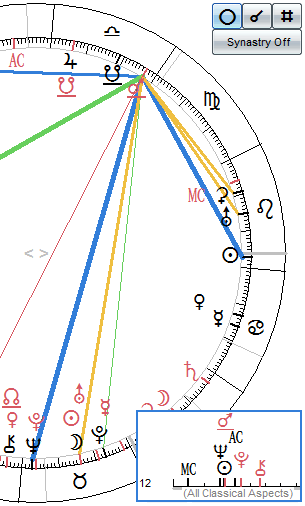
| What Watch? - Tutorial | Next chapter: Midpoints | Back to First Page |
Synastry, Composite and Davison charts
Bringing two charts in relationship, compare them and even merge them into one – using these techniques brings spice to astrology. Not only can you find out how people interact in synastry, drawing a composite or a Davison chart allows describing two people as an own entity. What Watch provides all three techniques, that can also be useful beyond partnership astrology: to make a link between a natal chart and current transits and progressions.
As soon as you enter birth data for a second person or a transit, the composite chart is created automatically. And on each individual wheel, you can add the other in synastry with a simple click. The Davison chart, however, must be calculated separately: on the input panel, choose the "composite" tab. There you'll find the data for the chart and two buttons to load it in one of the two chart wheels.
 |
Synastry
Conjunctions are always easy to spot. Higher aspects are more difficult to trace – What Watch offers a couple of techniques for this purpose. In the harmonic aspectarian interaspects between two charts can be easily spotted. Look at the 12th harmonic, a part of which is shown in the inset of the graphic. It shows planets that are in aspect by any multiple of 30 degrees. You find that the Sun and Neptune are in contact with the other person's Mars. The other's Pluto is also very near (about one degree away). If you look at the chart itself, you see black Neptune and red Pluto being in conjunction, black Neptune and red Mars forming a quincunx and red Mars and black Sun in sextile. So the other person's Mars and Pluto activate the natal Sun/Neptune square. Look at each harmonic and you'll find all the places in the chart activated by the other person. |
Another technique to show connections between two charts is also demonstrated in the example above. In the chart, click on the red Mars: the aspect lines drawn show all aspects between the red Mars and the black planets. Again, the sextile to the black Sun and the quincunx to the black Neptune are easy to spot.
By the way: The red planets belong to Sigmund Freud, the black ones to Carl Gustav Jung.
Composite and Davison chart
Comparing two charts in synastry is quite an old technique – however, composites and Davison charts have been invented only in recent decades. Both rely on the basic idea to merge two charts into one. In a composite, midpoints between the original planets and houses are used. In a Davison chart, there is a "real" chart drawn for the time and place halfway between the original ones. Because the composite is essentially a midpoint chart, not all astrological techniques can be used on it, eg you cannot calculate progressions for this type of chart. For a Davison chart, there are no such limitations.
Both techniques can be used in parallel. You can interpret a composite for any encounter of two people – but the information revealed will always be a bit superficial. The Davison chart is more profound: it shows how people interact who are committed to each other on a deeper level of the soul.
Literature:
Liz Greene - Relationships and How to Survive Them, CPA Press: London 1999
Jodie and Steven Forrest - Skymates (2 volumes), Seven Paws Press: Chapel Hill NC 2002 / 2005
Robert Hand - Planets in Composite, Whitford Press: Atglen PA 1975
Mona Riegger - Handbuch der Combin- und Composit-Deutung, Ebertin: Freiburg 1997 (German only)
| What Watch? - Tutorial | Next chapter: Midpoints | Back to First Page |